Discover the enchanting allure of Saint-Malo on a delightful day trip near Mont Saint-Michel. Explore its historic walls, sandy beaches, and maritime heritage. Join us for a memorable journey through this coastal gem.
Returning to the captivating region of Brittany during the Ascension Weekend of 2024, we embarked on our second journey to the enchanting Saint-Malo, this time accompanied by Thomas' parents. Our trip, meticulously planned, centered around a cozy cottage nestled near Dinan, from which we explored the picturesque surroundings. This return visit held a special significance as we immersed ourselves once again in the rich history and maritime allure of this fully-walled port city, recommended by Thomas' parents for its undeniable charm.
Walking through the old town with its cobbled streets and historical buildings, we felt transported to another time! Saint-Malo beautifully represents its colorful history, exuding the energy of its former corsairs and privateers. Join us as we delve deeper into this charming coastal gem in our blog post, offering tips and recommendations to help you plan a perfect day in Saint-Malo!

IN THIS GUIDE
1. General information
2. History
3. Tour of the ramparts
4. Intra-Muros walk
5. Explore the tidal islands
6. Getting there
7. Staying there
8. Eating there
9. Final thoughts
GENERAL INFORMATION
Located along the stunning Emerald Coast, Saint-Malo is not only one of France's remarkable cities but also one of the most visited destinations in Brittany. Surrounded by towering ramparts and embraced by the sea, it sits at the mouth of the Rance River, offering panoramic views of Dinard and the English Channel. With its vibrant maritime history, Saint-Malo has been a bustling center of trade, shaping its lively culture and charming atmosphere over the years.
As you plan your visit to Saint-Malo, it's essential to consider the time at your disposal. Even a brief stay unveils the city's allure, yet extending your visit allows for a deeper immersion. While a day provides a taste of its highlights, additional time offers the opportunity to unearth hidden treasures and embrace a more leisurely pace.
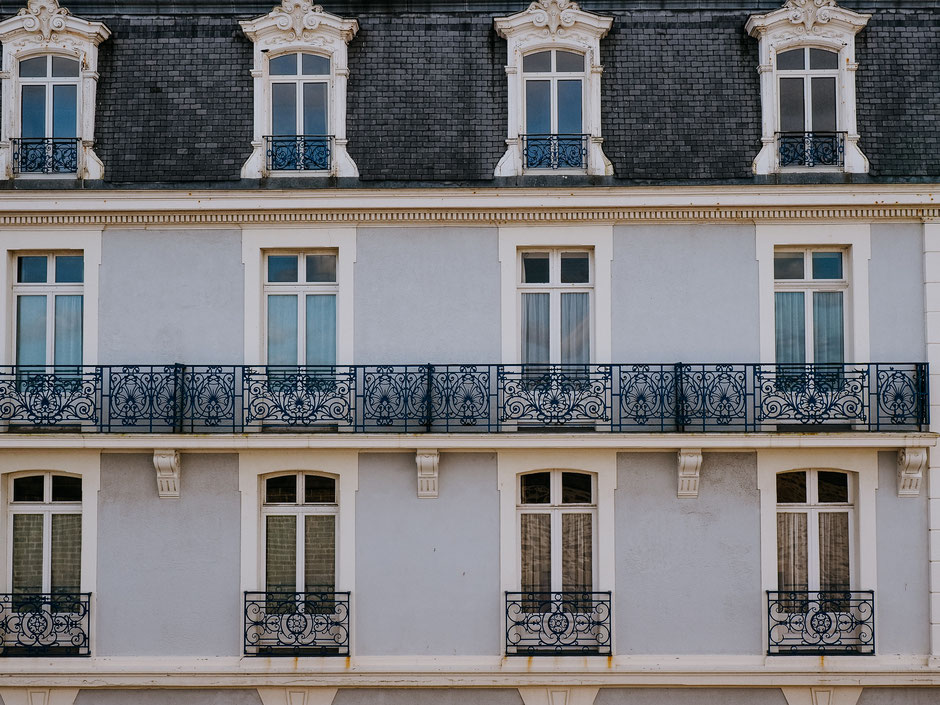
HISTORY
Founded in the 1st century BC by Gaulish tribes, Saint-Malo's origins trace back to its strategic location along the Brittany coast. Initially known as the Roman Reginca or Aletum, Saint-Malo evolved into a thriving port town renowned for its maritime prowess. During the Middle Ages, the city emerged as a hub of trade and commerce, attracting merchants and sailors from across Europe. Its strategic location made it a vital center for maritime trade, contributing to its prosperity and growth.
In the 17th and 18th centuries, Saint-Malo reached the pinnacle of its power and influence. The city became synonymous with piracy and privateering, with its skilled sailors and corsairs terrorizing the high seas and plundering enemy vessels. Notable figures such as Robert Surcouf gained fame and fortune through their daring exploits, solidifying Saint-Malo's reputation as a formidable maritime power. The city's golden age continued into the 19th century, marked by continued economic prosperity and cultural flourishing.
However, Saint-Malo's fortunes took a downturn with the advent of World War II. The city suffered extensive damage during the conflict, notably in the Allied bombing raids of 1944. Despite this devastation, Saint-Malo rose from the ashes through post-war restoration efforts, preserving its historic charm and ensuring its storied past remains vibrant today. This resilience is echoed in Anthony Doerr's novel "All the Light We Cannot See" and its subsequent series adaptation, which vividly portray the city's wartime experiences and enduring spirit.
Today, Saint-Malo stands as a testament to its resilient spirit and enduring legacy. Its ancient walls and fortifications bear witness to centuries of history, while its bustling port and vibrant cultural scene continue to captivate visitors from around the world.

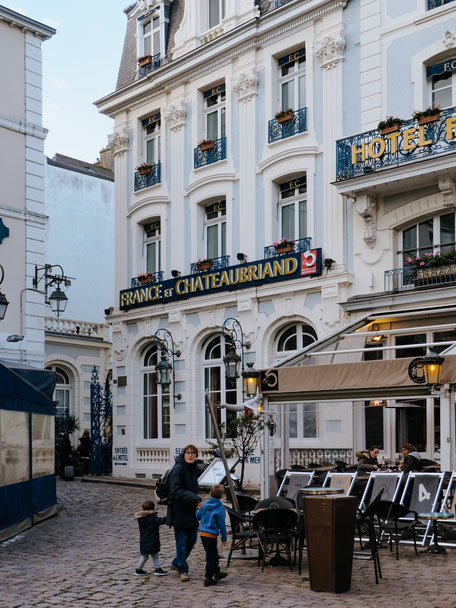
TOUR OF THE RAMPARTS
MÔLE DES NOIRES
To kick off our walking tour, begin by enjoying the views from the Môle des Noires, a 500-meter-long pier that adds a remarkable touch to the landscape. Not only does it offer scenic views, but it also acts as a protective barrier for the outer harbor. As we stroll along, the refreshing sea breeze invigorates us, and the sights of Saint-Malo's walled city against the vastness of the Atlantic Ocean are truly breathtaking. Trust us, this is a view you won't want to miss!
PORTE DE DINAN
Let's now begin the actual tour of the ramparts at Porte de Dinan. This route offers panoramic views of the old town and the surrounding turquoise waters, making it a picturesque stroll. The high wall that surrounds the city of Saint-Malo forms a loop of about two kilometers, taking roughly an hour to complete. If walking the entire length of the ramparts feels too much, don't worry! You can descend and ascend at various points along the route, using the different staircases located at each gate.



BASTION SAINT-PHILIPPE
Make your way towards the Bastion Saint-Philippe, a historic fortification located along the ramparts of the city. Named after Saint Philip, it served as a key defensive structure during the city's maritime heyday. Today, visitors can explore its sturdy walls and enjoy panoramic views of Môle beach and the Môle des Noires below.
BASTION DE LA HOLLANDE
A brief stroll from the Bastion Saint-Philippe leads to the Bastion de la Hollande, an imposing fortified tower built in the late 17th century. Originally armed with an impressive array of 24 cannons, its primary function was to defend Saint-Malo against potential attacks from the Dutch fleet, which gave the tower its name. Additionally, the tower accommodated a kennel of fierce bull dogs trained to protect the nearby Porte Saint-Pierre.
BIDOUANE TOWER
Now head towards the impressive Bidouane Tower. Standing tall at 23 meters, this tower was originally built in the 15th century and served as a gun-powder storage facility. Today, it offers a panoramic view of the shimmering waters surrounding the city. Visitors from this spot can enjoy breathtaking views of nearby fortified islands like Petit-Bé, Grand-Bé, and Fort National. These islands are easily reachable during low tide, though caution is necessary due to rising tides (more information on these islands in a section below).
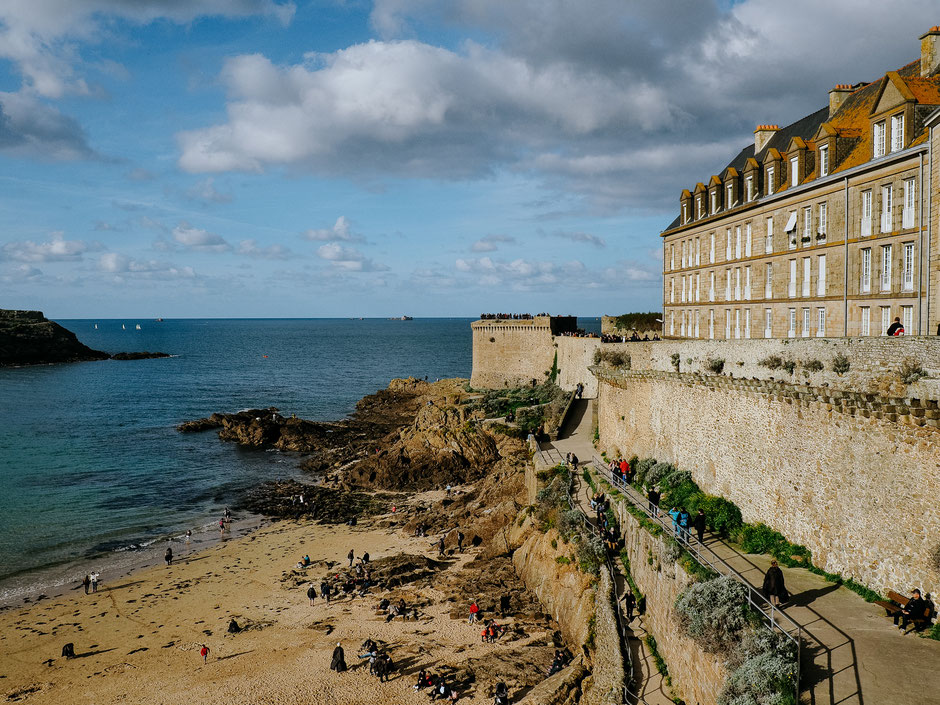
Bastion de la Reine
The Bastion de la Reine, another important fortification along the ramparts, holds historical importance as a defense structure protecting the city's northern edge. Named after Queen Anne, it symbolizes Saint-Malo's fortified past and maritime legacy. Built between 1714 and 1720 alongside the Bastion Saint-Philippe, it played a key role in the city's expansion and defense strategy. Moreover, the Bastion de la Reine has witnessed significant events in Saint-Malo's history. One notable incident was the failed attack by the "Machine Infernale," an English ship loaded with explosives. Intended to destroy Saint-Malo, the ship exploded near the bastion after running aground between the Fort à la Reine and the Bidouane Tower.
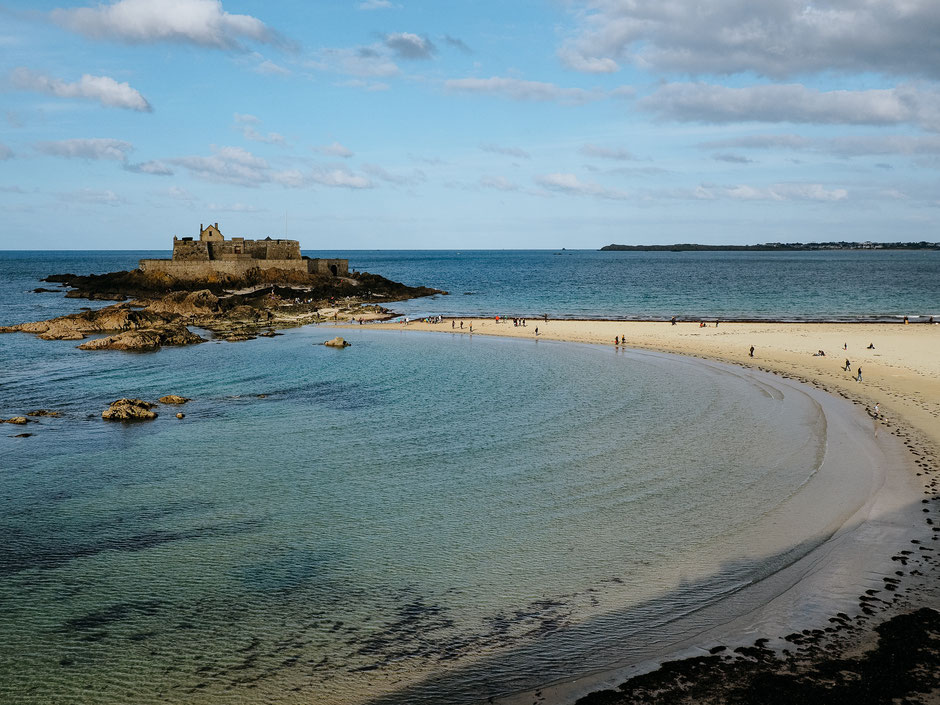
INTRA-MUROS WALK
Château de la Duchesse Anne
Let's now begin our tour of Saint-Malo Intra-Muros (which literally means “within the walls”). Head down the stairs of Porte Saint-Thomas towards the Château de la Duchesse Anne. This imposing fortress, named after Duchess Anne of Brittany, is a striking example of medieval architecture and a testament to the city's rich history. Originally built in the 15th century, the castle served as a residence for the dukes of Brittany and later as a prison during the 18th century. Nowadays, the castle is home to the Town Hall and cannot be visited.
PORTE SAINT-VINCENT
Close by, you'll come across Porte Saint-Vincent, which has become the main gateway to the Intra-Muros. This impressive double gate is beautifully decorated on its exterior with the symbols representing Brittany and the city. Just a short distance away, beyond the protective walls of the town, you'll find l'Étoile du Roy docked – a corsair frigate where you can immerse yourself in the life of a privateer and even venture out on sea excursions along the stunning Brittany coastline.
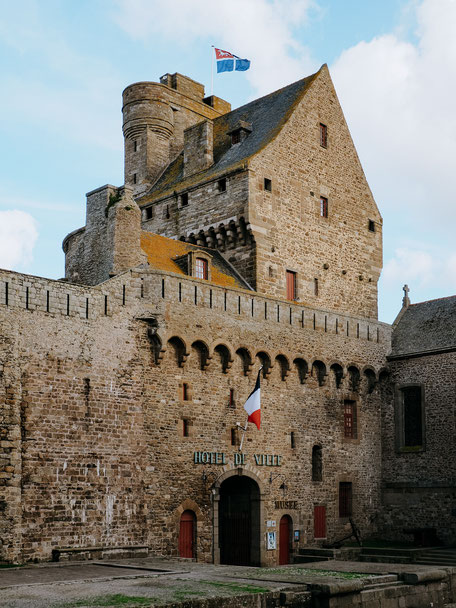
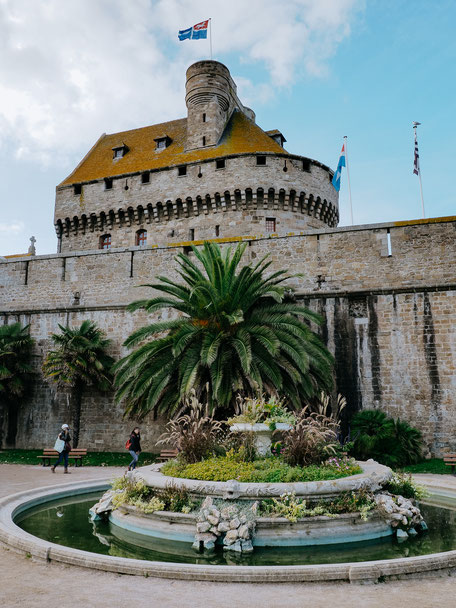

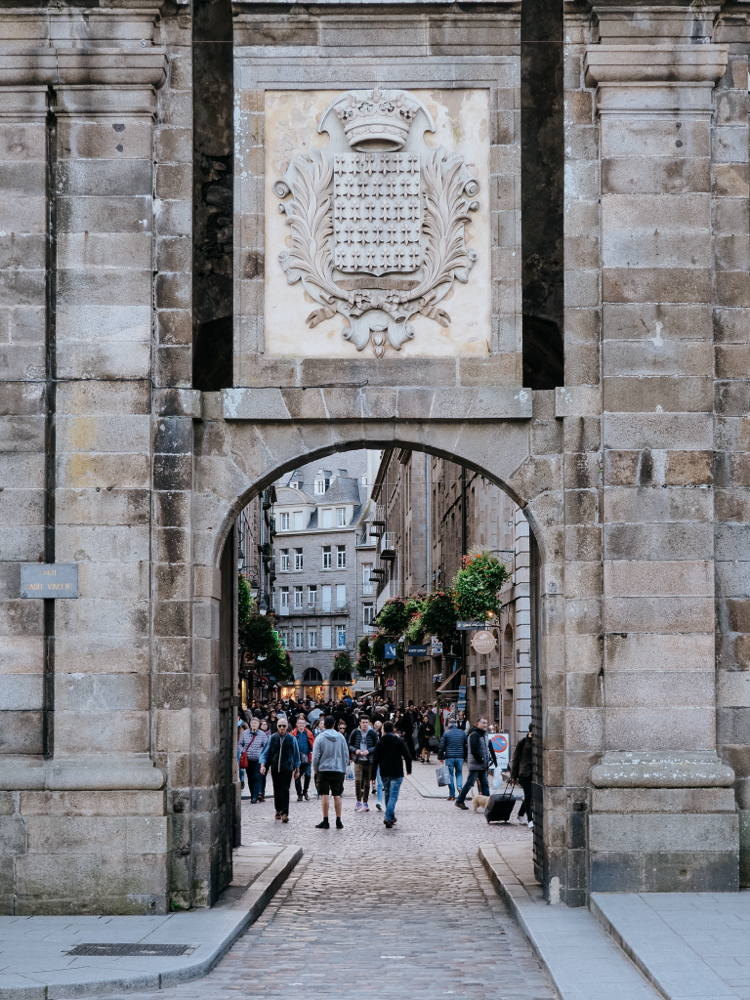
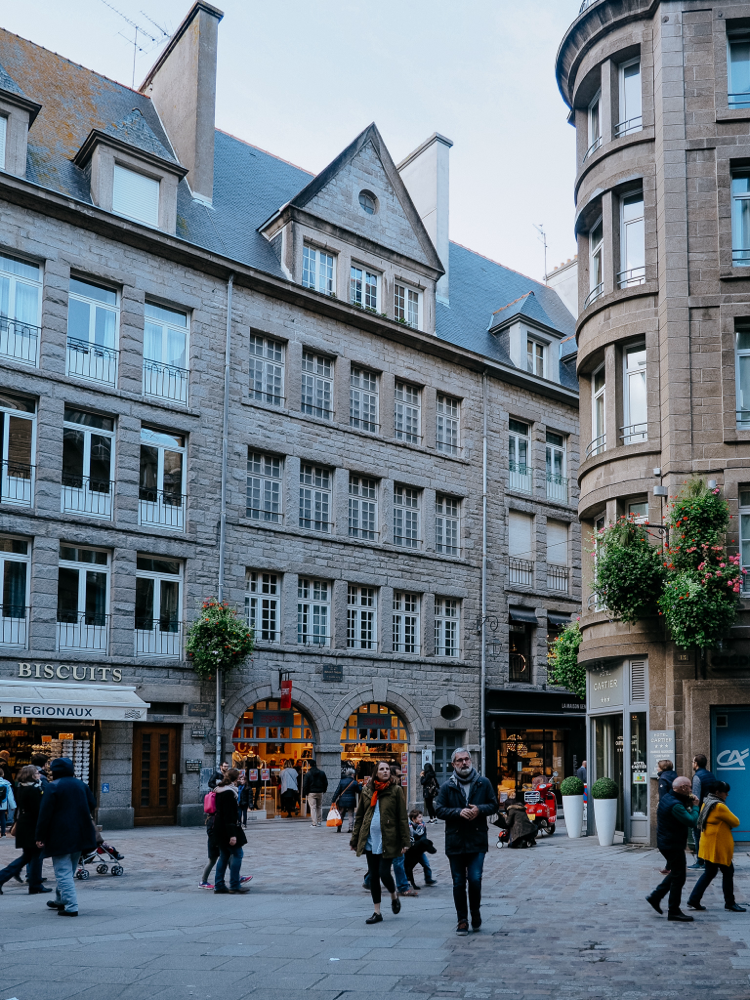
RUE DU PÉLICOT
Return to Intra-Muros and head towards Rue du Pélicot, where you'll be transported back in time to the late 15th century. The left side of the street, ascending, is lined with ancient homes that have endured through the ages. One notable residence, number 5, stands out with its wooden and glass façade, a rare survivor of fires in 1661 and 1944. Today, it serves as the International House of Poets and Writers, adding a touch of literary charm to this historic quarter. Further down the street, number 1 captivates with its 16th-century turret and intricately carved lintels, showcasing the craftsmanship of yesteryears.
SAINT-MALO CATHEDRAL
Make your way towards the impressive Cathedral Saint-Vincent-de-Saragosse de Saint-Malo, a stunning example of Roman and Gothic architectural styles. The cathedral has a rich history dating back to the 12th century. It was built between 1146 and 1174, during the reign of Bishop Jean de Chatillon. Throughout the centuries, the cathedral underwent several significant renovations and additions. In the 15th century, a new choir and transept were added, and in the 17th century, the nave was rebuilt in the Baroque style. During World War II, the cathedral was severely damaged by bombing, but it was later restored to its former glory. The cathedral's interior features several notable artworks and artifacts, including a 15th-century triptych and an 18th-century organ. It also houses the tomb of Jacques Cartier, a French explorer who discovered Canada and claimed it for France.
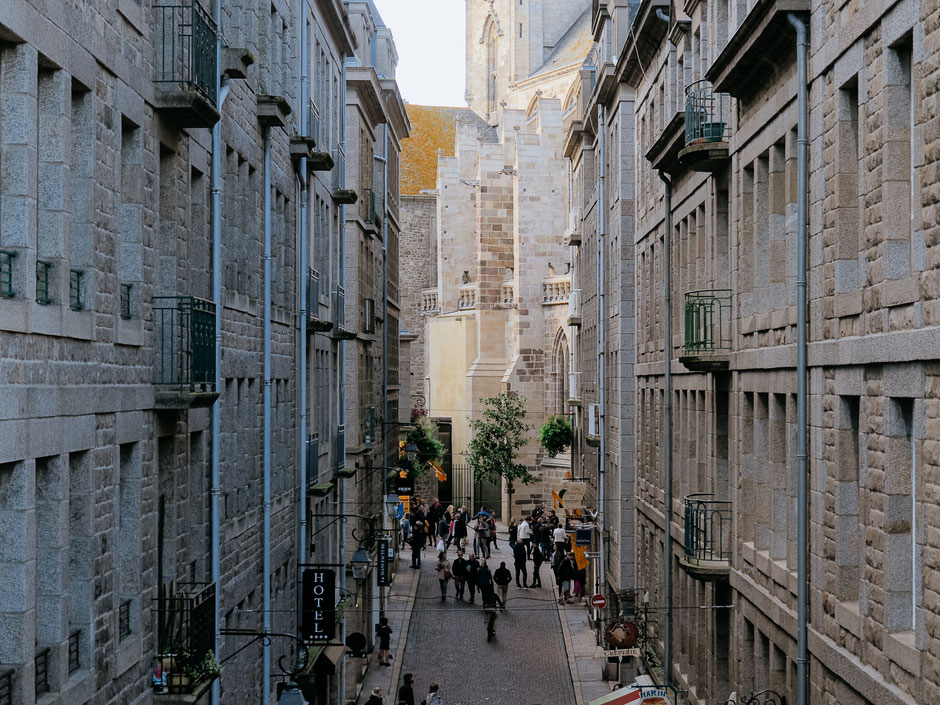

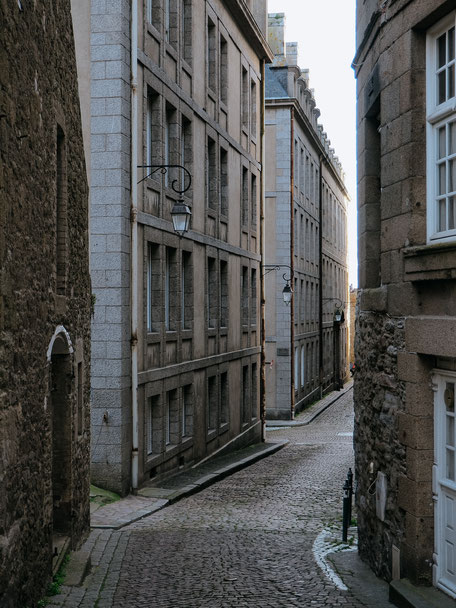
EXPLORE THE NARROW STREETS
Wander through the quaint streets of Saint-Malo's Intra-Muros and discover hidden gems at every turn. Head to Place de la Poissonnerie, where a Nordic-style hall built in 1954 serves as the fish market (currently closed). While Rue Jacques Cartier offers nice views, it's best to avoid dining there as most restaurants cater to tourists. Instead, try authentic cuisine at recommended spots listed at the end of this post. Don't forget to visit the historic Halle au Blé, a symbol of Saint-Malo's lively marketplace. Here, you can immerse yourself in the lively atmosphere, filled mostly with food items like butter or caramel treats.
Taste A DELICIOUS KOUIGN-AMANN
To wrap up our walking tour, treat yourself to a delightful culinary experience with the traditional Breton cake known as Kouign-amann. This round cake features layers of butter and sugar, expertly folded and caramelized to create a rich delight. Sample this delicacy, available at several locations across the city (check out our favorite locations listed at the end of this post), and explore different flavors like apple and salty caramel for a memorable gastronomic journey!

EXPLORE THE TIDAL ISLANDS
After exploring the historic ramparts and the charming streets of Saint-Malo's Intra-Muros, a visit to the tidal islands offers a unique experience. These islands, accessible only during low tide when natural land bridges appear, are both serene and historically significant. Grand-Bé, whose name means "tomb" in Celtic, holds cultural significance as the final resting place of French writer François-René de Chateaubriand and provides stunning coastal views. Nearby, Petit-Bé, with its 17th-century fortifications, adds a touch of historical intrigue. Further enriching the maritime adventure is Fort National, designed by Vauban in 1689, which sits on a rocky islet and once protected the city from invasions. Exploring these tidal islands deepens the appreciation of Saint-Malo's rich history and the timeless beauty of Brittany's coastline.
TRAVEL ESSENTIALS
GETTING THERE
Saint-Malo is easily accessible by various transportation modes, making it convenient for travelers to explore its historic streets and scenic coastline. Here's a guide on how to journey to Saint-Malo:
- By car: Driving to Saint-Malo offers flexibility and the opportunity to enjoy the picturesque landscapes of Brittany along the way. From Paris, take the A13 highway towards Rennes, then merge onto the N137 towards Saint-Malo. Follow signs for Saint-Malo, and upon arrival, park your vehicle in one of the designated parking areas conveniently located near the city center.
- By train: Saint-Malo is well-connected by train, with regular services operating from major cities like Paris, Rennes, and Nantes. TGV and TER trains provide comfortable and efficient travel options, offering scenic views of the coastline during the journey. Upon arrival at Saint-Malo's train station, it's just a short walk or taxi ride to reach the city center and begin exploring its attractions.
- By bus: Several bus companies offer services to Saint-Malo from nearby cities and towns. FlixBus, Ouibus, and regional bus companies provide affordable and convenient options for travelers seeking to reach Saint-Malo by bus. Buses typically drop passengers off at the Saint-Malo bus station, located within walking distance of the city center.
No matter which mode of transportation you choose, getting to Saint-Malo is the first step towards experiencing the charm and beauty of this coastal gem.
STAYING THERE
Saint-Malo offers a range of accommodation options to suit various tastes and budgets. Whether you prefer the charm of staying within the city walls or the tranquility of the surrounding areas, there's something for everyone. During our visit, we opted for a stay near Mont Saint-Michel to witness the island's nighttime allure. We chose Le Grenier du Jardin in Pontorson, an inviting Airbnb that exceeded our expectations. The accommodation provided a cozy atmosphere, allowing us to unwind after exploring the region. Situated just a short drive away from Mont Saint-Michel, Pontorson offered convenience without the bustling tourist crowds. Our stay was delightful, with spacious and clean rooms. The delicious breakfast and friendly owner added to the charm of our experience.
EATING THERE
Exploring the culinary scene in Saint-Malo reveals a plethora of dining options to tantalize your taste buds. Within the walled city, you'll discover a diverse array of restaurants offering local cuisine and international flavors. Here are some must-visit dining spots to consider:
- Le Bistrot du Rocher: Indulge in French culinary delights at Le Bistrot du Rocher, offering a cozy ambiance and a menu featuring classic dishes with a modern twist. Prices typically range from 20 EUR to 30 EUR per person for a main course.
- Crêperie Grain Noir: Savor the taste of authentic Breton crepes at Crêperie Grain Noir, where you'll find a wide selection of sweet and savory options to satisfy your cravings. Prices for crepes range from 8 EUR to 15 EUR, depending on the filling and size.
- Bergamote: Experience the warmth of authentic Breton cuisine in a casual setting. Sample traditional dishes like savory galettes (buckwheat crepes) filled with a variety of ingredients, hearty Breton stews, and fresh seafood caught locally. Prices average around 15 EUR to 25 EUR per person for a main course, excluding drinks.
- Les Embruns: At Les Embruns, relish a three-course menu for approximately 30 EUR per person. Start with succulent oysters, followed by their signature choucroute de la mer, and finish with delightful mignardises. Enjoy the essence of fresh seafood and regional specialties in each dish.
- Maison Galland, Kouign Amman de Saint-Malo: Treat yourself to delicious Kouign-amman at these locations. This traditional Breton cake, with layers of butter and sugar caramelized to perfection, comes in various tempting flavors like Nutella and salty caramel. Prices for Kouign-amann usually range from 5 EUR to 10 EUR per serving, depending on the flavor.
- La Maison du Beurre Bordier: Discover the art of butter-making at La Maison du Beurre Bordier and indulge in the rich flavors of handcrafted butter and dairy products. Prices vary depending on the products purchased.
- Épicerie La Maison du Sarrasin: Explore the flavors of Brittany at Epicerie La Maison du Sarrasin, a charming shop offering a variety of local products, including buckwheat specialties and artisanal goods. Prices vary depending on the products purchased.
With an abundance of dining options to choose from, Saint-Malo promises a culinary adventure filled with delicious flavors and memorable dining experiences. So, embark on a gastronomic journey and savor the best of Breton cuisine in this charming coastal city
FINAL THOUGHTS
Saint-Malo is a coastal treasure brimming with history, charm, and natural beauty. From its ancient walls to its sandy shores, every corner holds a story waiting to be discovered. If you opt for a longer stay, consider venturing to surrounding places like the Cité d'Alet or nearby towns reachable by ferry shuttle, such as Dinard or Cancale, each offering their own unique attractions and charm. As you bid farewell to Saint-Malo, remember to seize the opportunity to explore Mont Saint-Michel, just a short distance away. Be sure to check out our blog post here on Mont Saint-Michel to plan the ultimate day trip to this architectural masterpiece. With its proximity to Saint-Malo, it's an experience not to be missed!
Now we want to hear all about your impressions, thoughts, and tips for checking out Saint-Malo. Have you already visited this city? Drop your comments in the section below!



